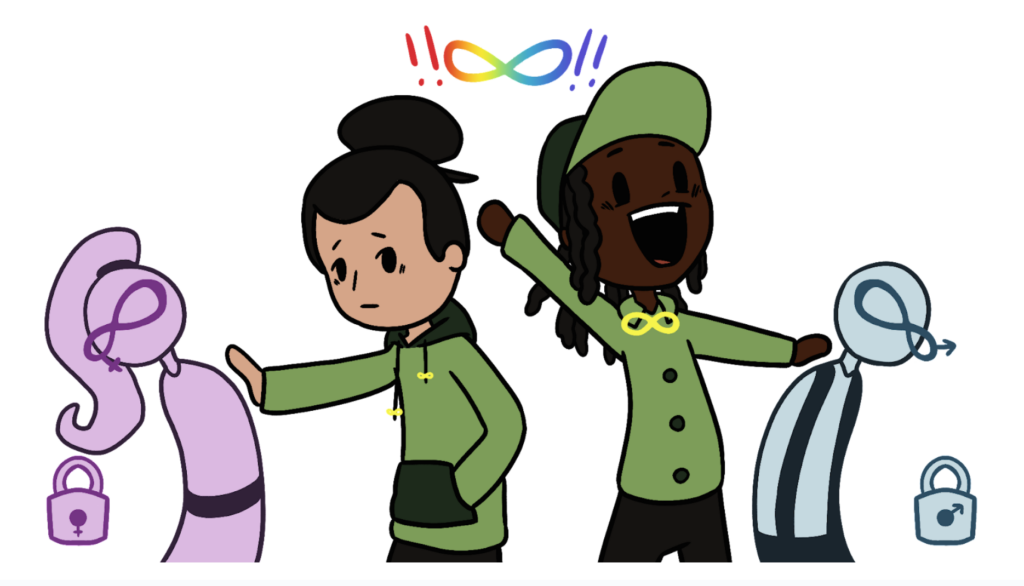You might see people talking about ‘male’ and ‘female’ autism. Often this is well-meaning. It comes from the fact that autism is thought to be underdiagnosed in women and girls because of the different ways in which it might show up. For example, people who are assigned female at birth might be more likely to mask their experiences from others, have special interests that are considered normal (such as dolls, ponies and makeup, rather than trains), or feel more pressure to look and act a certain way. This is all valid and is probably a part (but only a part!) of the reason for the lower levels of diagnosis.
So ‘male’ and ‘female’ autism might have been useful for improving our understanding of autism beyond boys and men. However, there are a few reasons why these terms can be unhelpful.
More and more research is showing not just that autism impacts women and girls, but that a very large number of autistic people are transgender, nonbinary or gender nonconforming. Some studies estimate that up to a quarter of gender diverse people are also autistic – that’s a huge overlap and something that we need to take notice of. This means only talking about “male” and “female” autism means a lot of people get missed. There are also lots of males who have what is known as a “female” presentation of autism and a lot of females who have a “male” presentation.
All of this makes sense when you think about the fact that autistic people are way less likely to do what is expected, and more likely to create our own way of being that doesn’t rely on social rules. So using terms like ‘male’ or ‘female’, which stem from a very mainstream understanding of the world, don’t really work when it comes to describing our experiences.
Many autistic people will tell you that their presentation of autism doesn’t fit their gender. That is because we are way more complex, unique and beautiful than that – and the richness of our experiences cannot be reduced to such limited terms.
So ‘male’ and ‘female’ autism might have been useful in improving our awareness of autism in the past – but to keep growing we need to ditch these terms and think in a way that truly reflects our diverse experiences.
writing led by Danny van Deurzen-Smith, autistic adult and coach

Instead of male and female autism, it might be helpful to talk about “externalised” and “internalised” autism.
When you have an externalised presentation (previously known as male autism), it is much easier for others to notice you are autistic:
-
- If a room is too loud, you may put on ear defenders or leave the room to avoid a meltdown.
-
- If you need movement to be able to listen, you may fidget a lot, pace up and down or move around in your seat.
Having an externalised presentation is the healthiest way to be. It means you feel ok to be yourself and can openly do what you need.
But it is important to know the difference between an externalised presentation because you feel safe and accepted, versus things you are doing because you don’t feel safe or you are struggling.
If you are feeling anxious a lot, if you have meltdowns often or feel stressed, this is likely to mean that you need more support or the current situation isn’t working very well for you.
Internalised autism (previously known as female autism) is where you may not appear different to other people because you “mask” your autistic traits. This often leads to a later diagnosis compared to others.
When you have an internalised presentation you are still autistic and it doesn’t mean you are “less autistic”. It means you may try to ignore what you need in order to fit in. This could mean:
-
- If a room is too loud, you may endure the noise to not appear different from other people.
-
- If you need a lot of movement to be able to listen, you may struggle to concentrate because you are trying to sit still like everyone else.
This can be very stressful. It takes a lot of energy to be able to ‘fit in’. If you mask, it makes sense and it often isn’t a choice. It is hard to be yourself when people aren’t very understanding.
But masking means you may not always get the support you need to make things easier for you. And if you mask for too long, it can lead to burnout.
How you act may be different depending on where you are too. For example, it is very common for us to hold in how we feel at school, and let our emotions out when we get home.
If you have an internalised presentation in some places, it may mean:
-
- The environment (including the people in it) needs to change so that you are more comfortable there.
-
- It might not be the right place for you if they don’t seem open to learning or changing.



